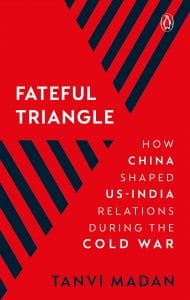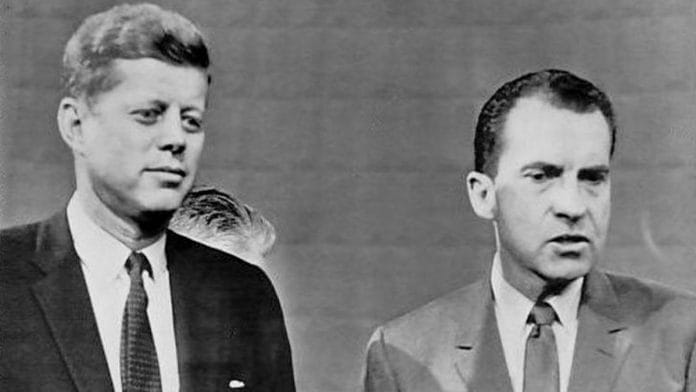On January 25, 2015, at 9:38 a.m., US president Barack Obama stepped off Air Force One onto the tarmac at Delhi’s Palam airport. Departing from protocol, Indian prime minister Narendra Modi was there to receive him. While the sky overhead was gloomy, the state of US- India relations was not.
Visible signs of how much the relationship had deepened over the previous decade and a half were everywhere, from the two leaders’ embrace on the tarmac to the reason for Obama’s visit—the first American president to be invited to be chief guest at India’s annual Republic Day celebrations—to the American strategic airlift and maritime reconnaissance aircraft acquired by India and featured in the parade. It was also evident in the two leaders’ declaration that a closer US-India partnership was not just important for their countries but “indispensable” for the peace, prosperity, and stability of the Indo- Pacific. But left unsaid and unseen was a crucial factor that had been driving this partnership: China.
In recent years, as China has continued to rise as an economic, political, and military power, the US and India have been increasingly interested in developing a strategic relationship in response. Most have seen this as a relatively recent framework for building US-India relations after five decades of viewing the bilateral relationship either through a US-India-Pakistan lens or a US-India-Soviet one.
Also read: When Trump visits, US and India must not get distracted by Pakistan & trade
For example, during the 2000 presidential election campaign, Condoleezza Rice argued that American foreign policy should move beyond the India- Pakistan conceptualization, emphasizing that the US “should pay closer attention to India’s role in the regional balance” in Asia given China’s rise. However, this strategic framework is not just a recent one. It echoes the framing from the first half of the Cold War, when the US in no small part viewed India through a China prism. The “loss” of China in 1949 had Time label India as the “anchor for Asia” and the New York Times emphasize that the US had a stake in India because it was “potentially a great counterweight to China.”
The concept of a “fateful race” between the two Asian giants took hold, with the Eisenhower administration noting in its 1957 statement of policy on South Asia that “the outcome of the competition between Communist China and India as to which can best satisfy the aspirations of peoples for economic improvement, will have a profound effect throughout Asia and Africa.” Consequently, the US needed to help India win the race—one of the few issues on which 1960 presidential contenders Senator John F. Kennedy and Vice President Richard Nixon agreed. This view endured through the Kennedy and Johnson administrations and then dissipated with Nixon’s 1971 rapprochement with China, only to reappear three decades later in the George W. Bush administration.
Even in India the China and US relationships were not treated in a stovepiped fashion. Indian policymakers, for example, used American concerns about China turning communist to elicit aid from the US. But they, too, bought into the idea of a development race and worried about the strategic consequences of falling behind. Initially, they saw the US as crucial to building India’s economic capabilities to deal with the symbolic and potentially strategic challenge that China posed. Later, when that country posed a military challenge, they turned to the US for assistance and assurance as well, even signing an air defense agreement in 1963 that called for mutual consultations in the event of a Chinese attack on India. Sino- US rapprochement put an end to this source of convergence, but it has reemerged in the two decades since Prime Minister Atal Behari Vajpayee argued in 2000 that, “above all,” shared interests in Asia demanded a closer US- India partnership.
Also read: India can’t continue to overlook Trump’s diplomatic slights. Time to redefine ties sensibly
While China played a significant role in shaping US- India relations in the past, this history has not been explored in any great detail. Most studies of US- India relations have focused on the impact of Pakistan, the former Soviet Union, personalities, economics, culture, or the two countries’ foreign policy traditions or ideologies. They have largely offered more explanation for estrangement than engagement, and for continuity than change, in the bilateral relationship.
Overall, in these analyses, consideration of the role of the other elephant— or, rather, dragon—in the room has been largely missing. The link between US relations with China and India, and India’s relations with China and the US has been left unexamined. A few scholars have assessed how China shaped the US- India relationship, but only in the context of limited events, such as the 1962 Sino- Indian War or the 1971 Indo- Pakistani War, or very briefly as part of a broader study. Others have even dismissed this role. One scholar, discussing US relations during the Cold War, for example, stated, “Washington’s policy toward India and Pakistan had its own trajectory that followed a different and separate path from that of US-China policy.”
As this book will demonstrate, however, those paths were not distinct. Washington’s China policy shaped its India policy, and Delhi’s perception of China affected how it dealt with the US. China was at times a source of tension in the relationship. However, it also helps explain, in large part, why the two countries continued to engage with each other, despite what an Indian official called a “range of irritants” in the relationship. A more comprehensive assessment of China’s role is essential to understanding the past trajectory of US- India relations. It can also shed light on the China- India- US triangle of today and of tomorrow. Moreover, it can help answer the often- asked question these days about the fate of this triangle: whether India and the US can and will ally or partner against China, given converging concerns about its rise, intentions, and actions.
 This excerpt from Fateful Triangle: How China shaped US-India relations during the Cold War by Tanvi Madan has been published with permission from Penguin Random House India.
This excerpt from Fateful Triangle: How China shaped US-India relations during the Cold War by Tanvi Madan has been published with permission from Penguin Random House India.






